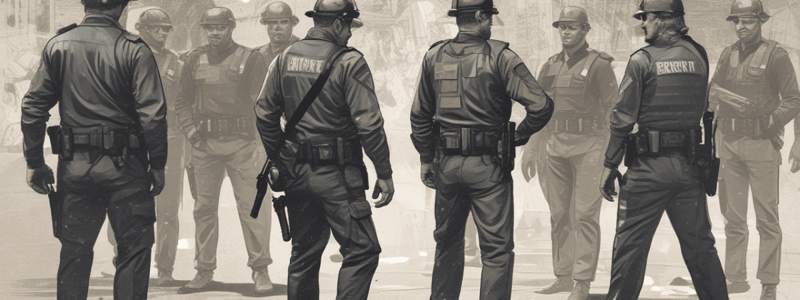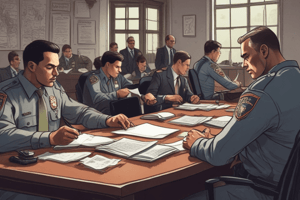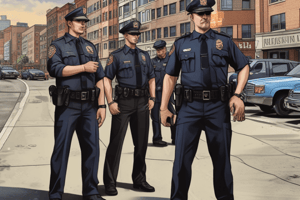Podcast
Questions and Answers
What is the primary objective of this lesson plan?
What is the primary objective of this lesson plan?
- To focus on verbal communication skills only
- To emphasize the importance of non-verbal signals
- To teach recruits how to respond to physical violence
- To provide recruits with skills to identify and diffuse aggressive behavior (correct)
What is the duration of this lesson plan?
What is the duration of this lesson plan?
- 4 hours (correct)
- 2 hours
- 8 hours
- 6 hours
What is the goal of active listening skills?
What is the goal of active listening skills?
- To Identify Verbal Aggression
- To Communicate Effectively with the Public (correct)
- To Diffuse Anxiety Behavior
- To Counter Physical Assaults
What is the significance of non-verbal and verbal signs?
What is the significance of non-verbal and verbal signs?
What is the importance of observing and listening?
What is the importance of observing and listening?
What is the purpose of diversionary techniques?
What is the purpose of diversionary techniques?
What is the significance of an assertive attitude?
What is the significance of an assertive attitude?
What is the ultimate goal of this lesson plan's objectives?
What is the ultimate goal of this lesson plan's objectives?
What is the primary benefit of utilizing an assertive attitude while communicating with the public?
What is the primary benefit of utilizing an assertive attitude while communicating with the public?
What is the primary goal of active listening skills?
What is the primary goal of active listening skills?
How should an officer respond to anxious or distressed behavior?
How should an officer respond to anxious or distressed behavior?
What is the primary goal of intervention techniques for verbal aggression?
What is the primary goal of intervention techniques for verbal aggression?
What is the purpose of identifying external clues in verbal aggression?
What is the purpose of identifying external clues in verbal aggression?
What is the primary goal of diversionary techniques in counter physical assault?
What is the primary goal of diversionary techniques in counter physical assault?
What is the purpose of having a mental plan in high-risk situations?
What is the purpose of having a mental plan in high-risk situations?
What should an officer prioritize when approaching a high-risk situation?
What should an officer prioritize when approaching a high-risk situation?
What is the primary benefit of practicing body movements in defensive tactics?
What is the primary benefit of practicing body movements in defensive tactics?
What is the primary goal of using positive verbal commands in diversionary techniques?
What is the primary goal of using positive verbal commands in diversionary techniques?
What percentage of time do Asians maintain eye contact?
What percentage of time do Asians maintain eye contact?
What can be inferred if someone avoids making eye contact in American society?
What can be inferred if someone avoids making eye contact in American society?
What can be indicated by gaze direction before a physical attack?
What can be indicated by gaze direction before a physical attack?
What can be inferred from a person's head position?
What can be inferred from a person's head position?
What can be indicated by a person's lip movements?
What can be indicated by a person's lip movements?
What can be indicated by a person's hand positioning?
What can be indicated by a person's hand positioning?
What can be indicated by a person's breathing rate?
What can be indicated by a person's breathing rate?
What can be indicated by a person's posture?
What can be indicated by a person's posture?
What can be indicated by a person's facial expressions?
What can be indicated by a person's facial expressions?
What can be indicated by a person's elbow positioning?
What can be indicated by a person's elbow positioning?
What does expanding the body to appear larger usually signify?
What does expanding the body to appear larger usually signify?
What happens when a person is cornered?
What happens when a person is cornered?
What is the recommended seating arrangement for effective communication?
What is the recommended seating arrangement for effective communication?
What is the recommended way to communicate verbally?
What is the recommended way to communicate verbally?
What is the purpose of repeating what the subject has said?
What is the purpose of repeating what the subject has said?
What is the recommended way to redirect anger?
What is the recommended way to redirect anger?
What is the risk of physically cornering a subject?
What is the risk of physically cornering a subject?
What is the recommended way to handle a subject who has conceded to leave an area?
What is the recommended way to handle a subject who has conceded to leave an area?
What is the purpose of asking questions in a non-threatening manner?
What is the purpose of asking questions in a non-threatening manner?
What is the recommended tone of voice for communication?
What is the recommended tone of voice for communication?
What is the recommended distance to approach someone to avoid invading their personal zone?
What is the recommended distance to approach someone to avoid invading their personal zone?
What is the purpose of blading your body at forty-five degrees when approaching someone?
What is the purpose of blading your body at forty-five degrees when approaching someone?
What is the 'Father Murphy' position in de-escalation techniques?
What is the 'Father Murphy' position in de-escalation techniques?
What is the term for the study of personal and cultural needs of people and the interaction of space and communication?
What is the term for the study of personal and cultural needs of people and the interaction of space and communication?
What is the approximate distance of the intimate zone in Proxemics?
What is the approximate distance of the intimate zone in Proxemics?
What is the purpose of maintaining eye contact in communication?
What is the purpose of maintaining eye contact in communication?
How often should you maintain eye contact when speaking to someone?
How often should you maintain eye contact when speaking to someone?
What is the recommended response to someone who is not making eye contact?
What is the recommended response to someone who is not making eye contact?
What is the purpose of breaking eye contact in communication?
What is the purpose of breaking eye contact in communication?
What is the cultural difference in personal space that is observed in people raised in crowded cities?
What is the cultural difference in personal space that is observed in people raised in crowded cities?
What is a common physiological response when an individual is preparing to attack?
What is a common physiological response when an individual is preparing to attack?
What is the recommended response when you see several or a cluster of aggressive signals?
What is the recommended response when you see several or a cluster of aggressive signals?
What is a sign of submission in an aggressor?
What is a sign of submission in an aggressor?
What is the single most important word in the dictionary according to the text?
What is the single most important word in the dictionary according to the text?
Why is it important to consider factors such as age, size, and gender when using force?
Why is it important to consider factors such as age, size, and gender when using force?
What is the purpose of re-directed activity in aggression?
What is the purpose of re-directed activity in aggression?
Why is walking with someone effective in reducing anxiety?
Why is walking with someone effective in reducing anxiety?
What percentage of communication is verbal, according to the text?
What percentage of communication is verbal, according to the text?
What happens when an aggressor's parasympathetic nervous system takes over?
What happens when an aggressor's parasympathetic nervous system takes over?
What is the recommended response when an aggressor is in close proximity to a firearm?
What is the recommended response when an aggressor is in close proximity to a firearm?
What is the purpose of using positive commands like 'STOP'?
What is the purpose of using positive commands like 'STOP'?
Why is it important to prioritize justification of your actions in a report?
Why is it important to prioritize justification of your actions in a report?
What is the result of using loud and positive voice commands in a situation of imminent assault?
What is the result of using loud and positive voice commands in a situation of imminent assault?
What is the importance of continued verbalization in a situation of conflict?
What is the importance of continued verbalization in a situation of conflict?
What is the definition of empathy in active listening?
What is the definition of empathy in active listening?
How fast do we hear compared to how fast we speak, according to the text?
How fast do we hear compared to how fast we speak, according to the text?
What is the importance of avoiding starting sentences with 'YOU' in active listening?
What is the importance of avoiding starting sentences with 'YOU' in active listening?
Why is body language important in active listening?
Why is body language important in active listening?
What is the primary purpose of the first stage of conflict?
What is the primary purpose of the first stage of conflict?
What is the physical response to the release of adrenaline in the first stage of conflict?
What is the physical response to the release of adrenaline in the first stage of conflict?
What is the purpose of 'ritualized combat' in the second stage of conflict?
What is the purpose of 'ritualized combat' in the second stage of conflict?
What is the recommended verbal response to an aggressor in the second stage of conflict?
What is the recommended verbal response to an aggressor in the second stage of conflict?
What is the physical response to increased adrenaline flow in the second stage of conflict?
What is the physical response to increased adrenaline flow in the second stage of conflict?
What is the goal of management in the second stage of conflict?
What is the goal of management in the second stage of conflict?
What is the physical response to losing control physically in the third stage of conflict?
What is the physical response to losing control physically in the third stage of conflict?
What is the recommended non-verbal response to an aggressor in the second stage of conflict?
What is the recommended non-verbal response to an aggressor in the second stage of conflict?
What is the purpose of setting limits in the management of conflict?
What is the purpose of setting limits in the management of conflict?
What is the result of failing to enforce limits in the management of conflict?
What is the result of failing to enforce limits in the management of conflict?
Flashcards are hidden until you start studying
Study Notes
Preventing and Diffusing Aggressive Behavior
- This section aims to provide recruits with basic skills to identify and manage aggressive behavior, using communication and behavioral tools to prevent or diffuse aggression.
Assertive Attitude
- Characteristics of an assertive attitude: win-win interaction, listening, and respect.
- Benefits of assertive attitude: establishes trust, honesty, and cooperation.
Active Listening Skills
- Empathetic skills: create an impression of concern, willingness to listen, and allow venting.
- Key elements: body language, paralanguage, proxemics, and kinesics.
Intervention Responses
- Appropriate responses to different behaviors:
- Anxiety: supportive.
- Verbal aggression: assertive.
- Physical violence: defensive.
Diffusing Anxiety Behavior
- Supportive techniques:
- Introduce yourself.
- Ask to repeat.
- Ask questions.
- Use reflective techniques.
- Clarify implied statements.
- Isolate the problem.
- Redirect anger to the past.
- Use their name.
- Use "we".
- Get them to sit or walk.
- Use pacing and voice control.
Diffusing Verbal Aggression
- Techniques:
- Allow venting.
- Active listening.
- Set clear limits.
- Enforce limits.
- Use positive verbal commands.
Intervention Diversionary Techniques
- Techniques:
- Practiced body movements.
- Defensive tactics.
- Effective body language.
- Positive verbal commands.
- Throwing or dropping objects.
The Approach
- Mental preparation: plan for potential violence.
- Physical preparation:
- Take three deep breaths.
- Approach at a safe distance (4-6 feet).
- Approach at a 45-degree angle.
- Keep hands at waist level.
- Keep feet shoulder-width apart.
Space (Proxemics)
- Understanding personal and cultural needs of space.
- Four zones: intimate, personal, social, and public.
- Environmental and cultural differences affect personal space.
- Gender and age differences in personal space.
Eye Contact
- Importance of eye contact in non-verbal communication.
- Eye contact can indicate:
- Concern.
- Support.
- Confidence.
- Authority.
- Cultural differences in eye contact.
- Maintaining eye contact:
- 45% of the time.
- Reducing eye contact can help maintain a "helper" role.
Gestures and Posture
- Head:
- Back: aggression.
- Straight: assertiveness.
- Bowed or nodding: support or submission.
- Face:
- Tension.
- Teeth clenched.
- Skin color.
- Lips:
- Quivering: anxiety.
- Pushed forward: anger.
- Tight or tense: assault imminent.
- Breathing:
- Rate increases with aggression.
- Heaving chest: sign of attack.
- Shoulders:
- Back: aggression.
- Straight: assertiveness.
- Forward: submission.
- Arms:
- Crossed and high: aggression.
- Loosely crossed and low: non-aggression.
- Above waist and out: non-aggressive.
- Above waist and in: aggression.
- Above waist and bladed: aggression.
- Below waist and in: non-aggressive.
- Below waist and out: possible aggression.
- Palms:
- Wrings: anxiety.
- Opening and closing: aggression.
- On hips: assertion.
- Folded in front of groin: non-aggressive.
- In boxing stance: aggressive.
- Closed fists: aggressive.
- One hand open, one closed: look for weapon.
- One or both behind back: watch for weapons.
- Elbows:
- Close to body: tension.
- Away from body: relaxed.
- Index fingers:
- Pulling trigger: aggression.
- Runs across throat: aggression.
- Legs or stance:
- Weight equal on both feet: non-aggressive.
- Bobbing up and down: aggression.
- Rocking toes to heels: aggression.
- Front knee bent, rear locked: aggression.
- Shift body toward you: aggression.
- Shift body away: looking for escape, weapon, or submission.
Verbal Communications
-
Importance of verbal communication in de-escalation.
-
Key elements:
- Calm and reassuring voice.
- Tone of voice.
- Volume.
- Rate of speech.
-
Techniques:
- Introduction.
- Ask questions.
- Repeat what they say.
- Use active listening.
- Redirect anger.
- Use voice control.
- Use positive commands.### Conflict Resolution
-
When dealing with an aggressor, continue to verbalize commands to create an intense state of conflict between aggression and fear.
-
Use active listening to open and maintain communication, including empathy, listening, paralanguage, and body language.
Active Listening
- Empathy: Put yourself in another's shoes and listen to their ideas or problems.
- Listen: Listening shows concern and allows for venting anger or frustration.
- Avoid labeling or prejudging people; their problems are real to them.
- Body language: Tilt your head to show interest, nod your head to show understanding, and keep your hands open.
Stages of Conflict
- There are three stages of conflict:
- Anxiety: Fear, hate, disappointment, sorrow, jealousy, stress, guilt, paranoia, distrust of authority, or feeling cornered.
- Losing control verbally: Verbal aggression, threats, and counter-threats.
- Losing control physically: Physical action, such as fighting.
Recognizing Loss of Control
- People lose control to establish dominance in a social hierarchy or to establish territorial rights.
- External changes: Face color darkens, veins appear, lips are licked, little eye contact, shallow breathing, sighing, and eyebrows frown.
- Internal changes: Increased heart rate, increased blood pressure, and adrenaline release.
Management
- Reduce anxiety by active listening.
- Non-verbal: Be assertive, non-threatening, and maintain eye contact.
- Verbal: Allow venting, set limits, and give directions.
- Physical: Separate aggressors, substitute yourself, and move away.
- If losing control physically, create space, use loud positive commands, and divert attention.
Losing Control Physically
- External changes: Face color changes, distortion of the left side of the face, aggressors break their stare, and verbalization stops.
- Internal changes: Heart rate high, blood pressure high, tunnel vision, auditory exclusion, and large amounts of adrenaline flow.
Management of Physical Loss of Control
- Create space, use loud positive commands, and divert attention.
- Use defensive tools, such as OC Spray, PR-24, or an Expandable baton.
- Move quickly into an escort position and take control of the aggressor.
Signals of Submission
- Put hands up, palms out.
- State "I give up".
- Turning back with hands covering the head.
- Reduction in violent movement.
- Bowing head.
- Lowering eyes and looking down.
- Verbal tone and volume decrease.
- Total inactivity.
Studying That Suits You
Use AI to generate personalized quizzes and flashcards to suit your learning preferences.




